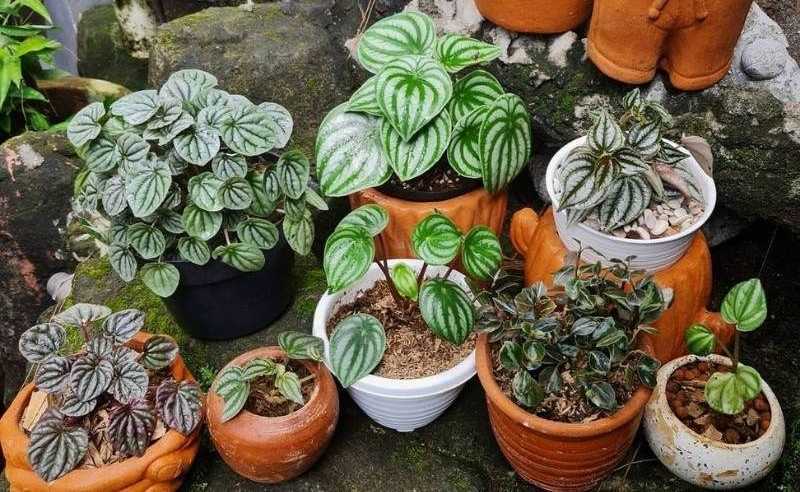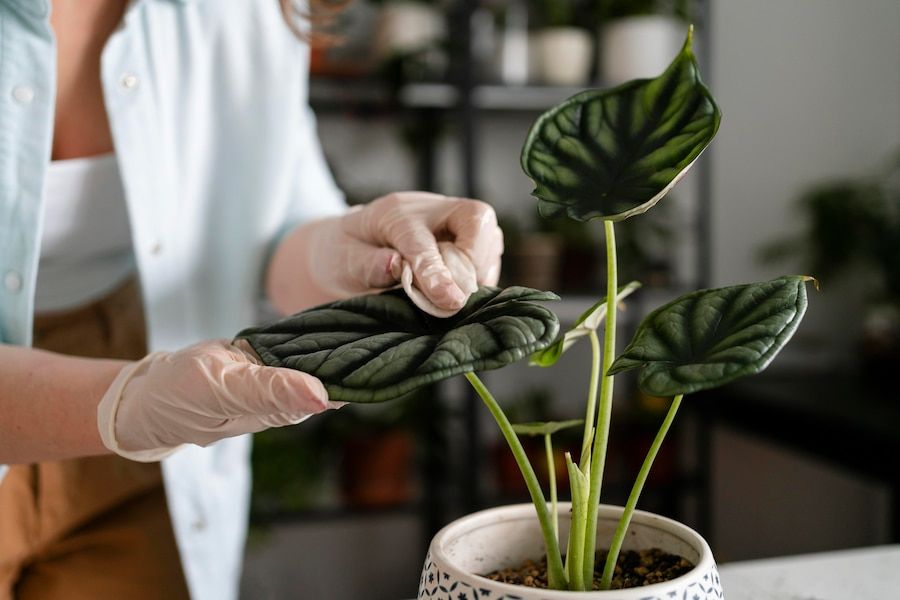Peperomia, a genus of small, tropical plants, has become a cherished addition to many households and gardens around the world. One of the most intriguing aspects of Peperomia is the wide array of leaf shapes and textures among its species. From heart-shaped to oval, variegated to solid-colored, the leaves of Peperomia plants present an artistic palette for nature enthusiasts.
There are numerous species and varieties, each with its unique characteristics. The foliage ranges from glossy to matte, adding further visual interest to these captivating plants.
Peperomias are known for their attractive, often succulent, and thick leaves. Leaf shapes vary among species and can be round, heart-shaped, or more elongated. Here’s a general overview of Peperomia plant varieties and how to care for them.
Special Varieties:
The genus includes various species and cultivars, such as:



1. Peperomia Watermelon (Peperomia argyreia):
Known for its distinctive watermelon-like leaf patterns. The elliptical leaves feature a vibrant green color with silver stripes, creating an eye-catching appearance. This species is appreciated not only for its aesthetics but also for its ease of care, making it a popular choice for both beginners and experienced plant enthusiasts.
2. Peperomia obtusifolia (Baby Rubber Plant):
Known for its thick, succulent-like leaves and easy care, this species is a favorite among indoor gardeners. Its compact size and adaptability to low light conditions make it an ideal choice for those seeking a resilient houseplant.
3. Peperomia caperata (Radiator Plant):
Recognized by its corrugated leaves that resemble a radiator, this species adds texture to any plant collection. With varieties displaying hues ranging from deep green to red, the Peperomia Caperata is a striking choice for those seeking a pop of color.
4. Peperomia Polybotrya (Raindrop)
Characterized by its teardrop-shaped leaves, Peperomia Polybotrya adds an elegant touch to any plant collection. The glossy, dark green leaves, coupled with its compact size, make it a popular choice for tabletops and shelves. Its graceful appearance and minimal care requirements contribute to its rising popularity among indoor gardeners.
5. Peperomia Prostrata (String of Turtles)
Peperomia Prostrata, also known as the String of Turtles, is a trailing species celebrated for its unique leaf markings resembling turtle shells. Its small, round leaves cascade elegantly, making it an excellent choice for hanging baskets or as a trailing accent in plant arrangements. This species adds a touch of whimsy to any plant collection.
Peperomia Care Guidelines:



Light:
- Preference: Medium to bright, indirect light. Some Peperomia plant varieties can tolerate lower light levels.
- Avoid: Direct sunlight, as it can scorch the leaves.
Watering:
- Frequency: Allow the top inch (2.5 cm) of the soil to dry before watering.
- Avoid: Overwatering can lead to root rot. Ensure adequate drainage and don’t let the plant sit in water.
Soil:
- Type: Use a well-draining potting mix. A mix designed for succulents or cacti can work well.
- Additives: Peat moss or perlite can enhance drainage.
Humidity:
- Tolerance: Peperomia plants are adaptable to normal indoor humidity levels.
- Appreciates: They may benefit from occasional misting, especially in drier environments.
Temperature:
- Range: Peperomias prefer temperatures between 65-75°F (18-24°C).
- Avoid: Protect them from drafts and sudden temperature fluctuations.
Fertilization:
- Frequency: Feed with a balanced, diluted liquid fertilizer every 4-6 weeks during the growing season (spring and summer).
- Reduce in Winter: Reduce or stop fertilizing in the fall and winter when growth slows down.
Pruning:
- Purpose: Prune to control size and shape or to remove leggy growth.
- Technique: Pinch or trim with clean scissors or pruning shears.
Propagation:
- Method: Peperomias can be propagated through leaf or stem cuttings.
- Process: Take a cutting with at least one leaf and plant it in a well-draining medium.
Peperomia Common Issues:
Overwatering is a common problem, leading to yellowing leaves and potential root rot. To address this, allow the soil to dry out between waterings and ensure proper drainage. On the flip side, underwatering can result in drooping or wrinkled leaves, so maintain a consistent watering schedule. Peperomia plants may also attract pests like spider mites or aphids, which can be mitigated with insecticidal soap.
Root rot is another concern related to excessive moisture; in such cases, trimming affected roots and repotting in well-draining soil can help. Lastly, yellow leaves may indicate various issues, including nutrient deficiencies or exposure to direct sunlight. Regular monitoring, adjusting care routines, and addressing these issues promptly can help keep Peperomia plants thriving.
Conclusion:
Peperomias are excellent choices for indoor plants due to their adaptability and varied aesthetics. Their diverse leaf varieties, easy maintenance, and adaptability to different environments make them a perfect choice for plant enthusiasts seeking a unique and charming addition to their collection. Tailor your care routine based on the specific variety of Peperomia you have, and enjoy the lush greenery these charming plants bring to your home.

